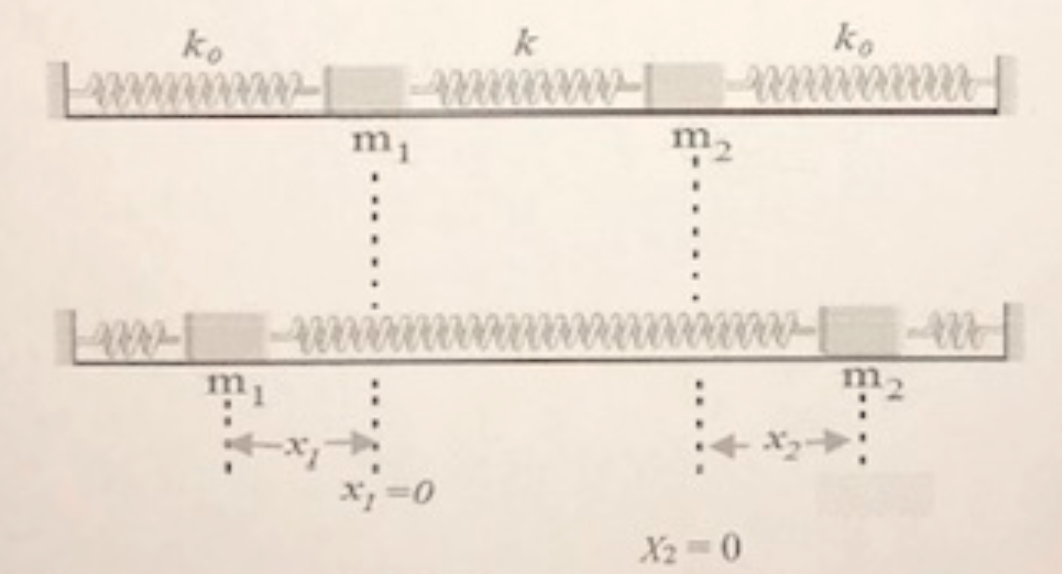Thanks for defining $x$, with that, I can explain what the problem is. I assume that by the way you drew $x_1$ and $x_2$, this also defines the positive values of $x_1$ and $x_2$.
The thing is that you give $x_1$ and $x_2$ with reference to some equilibrium positions $x_{1e}$ and $x_{2e}$. You can define the harmonic motion in this coordinate system, but it's a bit tricky to justify exactly why the terms aris the way they do.
The no-brain way of doing it is to start with $x_1$ and $x_2$ with reference to the same origin. Say $x_1$ were the distance of mass 1 from the point where the left spring is attached to the wall, and $x_2$ were the distance of mass 2 from the same point. Then you can go ahead and model all three springs. The length of the first spring would be $x_1$, the length of the second spring would be $x_2 - x_1$ and the lenght of the third spring is $L - x_2$. Clearly, $x_1$ feels the forces due to the first and second spring, and each force is the spring constant times the length, so
$$m \ddot{x}_1 = - k_0 x_1 + k (x_2 - x_1).$$
The signs are there because the left spring pulls $x_1$ to the left (against the positive direction of the coordinate system we just chose) while the middle spring gives rise to a pull to the right (in the positive direction of the coordinate system). Similarly, you find
$$m \ddot{x}_2 = k_0 (L - x_2) - k (x_2 - x_1).$$
This time, the right spring pulls to the right while the middle spring pulls to the left, so you get the opposite signs. Therefore, you have a matrix equation
$$\frac{\textrm{d}^2}{\textrm{d}t^2}\begin{pmatrix} x_1 \\ x_2\end{pmatrix}
= \begin{pmatrix} - (k + k_0) & k \\ k & -(k + k_0)\end{pmatrix}\begin{pmatrix} x_1 \\ x_2\end{pmatrix} + k_0 L \begin{pmatrix} 0 \\ 1\end{pmatrix},$$
and you can proceed to calculate the frequencies from the frequency matrix.
Link between descriptions
I had kind of a brainblockage yesterday, so I got a bit confused about the use of different equilibrium positions. So to get this straight: You can transform the above equation to arbitrary coordinate origins for $x_1$ and $x_2$. Let's write new coordinates with the transform $x_1 \mapsto x_1' = x_1 - x_{1e}$ and $x_2 \mapsto x_2' = x_2 - x_{2e}$. Evidently, $\textrm{d}^2/\textrm{d}t^2 x_i' = \textrm{d}^2/\textrm{d}t^2 x_i$ for $i \in \{1,2\}$, and by insertion we have
$$\frac{\textrm{d}^2}{\textrm{d}t^2}\begin{pmatrix} x_1' \\ x_2'\end{pmatrix}
= \begin{pmatrix} - (k + k_0) & k \\ k & -(k + k_0)\end{pmatrix}\begin{pmatrix} x_1' + x_{1e} \\ x_2' + x_{2e}\end{pmatrix} + k_0 L \begin{pmatrix} 0 \\ 1\end{pmatrix}.$$
Now if you deliberately choose the positions $x_{1e}$ and $x_{2e}$ to be the equilibrium posistion, i.e.
$$\begin{pmatrix} - (k + k_0) & k \\ k & -(k + k_0)\end{pmatrix}\begin{pmatrix} x_{1e} \\ x_{2e}\end{pmatrix} + k_0 L \begin{pmatrix} 0 \\ 1\end{pmatrix} = 0,$$
which is just the requirement that the masses feel no acceleration in this particular configuration, you arrive at
$$\frac{\textrm{d}^2}{\textrm{d}t^2}\begin{pmatrix} x_1' \\ x_2'\end{pmatrix}
= \begin{pmatrix} - (k + k_0) & k \\ k & -(k + k_0)\end{pmatrix}\begin{pmatrix} x_1' \\ x_2'\end{pmatrix}.$$



